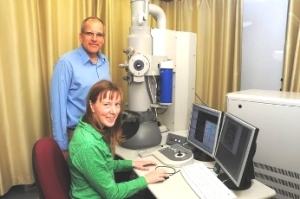Sep 27 2010
A new type of nanoparticle resembling the six-pointed Star of David (Magen David) that is the symbol on the flag of Israel has been discovered by researchers at the Hebrew University of Jerusalem. (One nanometer is a billionth of a meter.)
The discovery, the researchers say, may lead to new ways for sensing of glucose in diagnosing diabetes or provide a catalyst to capture the sun's energy and turn it into clean fuel.
 New nanomaterial shaped like Stars of David
New nanomaterial shaped like Stars of David
Their work, they further believe, greatly contributes to understanding how hybrid nanoparticles form. Hybrid nanoparticles are systems which combine two or more different materials on the same particle in which the combination provides multi-functionality to the particle. The discovery of the Hebrew University scientists is described in an article published now online and in the October 2010 issue of the journal Nature Materials.
The new Star of David shaped particles, with sizes 10,000 times smaller than the width of a human hair, were discovered by the research group of Uri Banin, the Alfred and Erica Larisch Memorial Professor and the director of the Harvey M. Kruger Family Center for Nanoscience and Nanotechnology at the Hebrew University.
The researchers have been working to try and develop new nanoparticles made of two kinds of materials joined together. So far, scientists have only been aware of nanoparticles in which one material encapsulates the other (resembling an egg and a yolk), or where an island of one material forms on the other (much like the head of the match on a match-stick). This was not the case with the Star of David shapes.
Dr. Janet Macdonald, a postdoctoral fellow in Banin’s group, worked on synthesizing nanoparticles combining copper sulfide, a common mineral with semiconducting properties, and ruthenium, a metal with exceptional chemical-catalytic properties. Instead of the expected ruthenium islands on the seed particles, what she saw in the pictures from the electron microscope were particles with surprising striped patterns and Star of David shapes.
What followed was the difficult task of figuring out the three-dimensional shape of the particles that could give such images. The mystery took months to solve and confirm by careful analysis and with the aid of Dr. Maya Bar Sadan and Dr. Lothar Houben of the Ernst Ruska-Centre for Microscopy and Spectroscopy with Electrons in Juelich, Germany.
The researchers generated a three-dimensional image of the tiny nanoparticles using a powerful electron microscope and found that the Stars of David are, remarkably, “nano-cages.” The particles are nano-sized, hexagonal crystals, each with a tiny metal frame wrapping around and encasing them just like a bird’s cage, but 100 million times smaller. Because the nano-cage is hexagonal, when looking at pictures of them from above, they appear as Stars of David. No one had ever seen hybrid nanoparticles form with such a cage structure before.
Exploration into the possible applications for the nano Stars of David has just begun, and already they have shown that they are not just beautiful; the composition and the unique cage shape makes them useful. The first application demonstrated was in the use of the nano-cages as sensors. The researchers coated an electrode with the Star of David nano-cages and proved that it is possible to detect with the new device minute quantities of hydrogen peroxide. Uncaged copper sulfide particles alone were not sensitive, and remarkably, the addition of the metal frame boosted the electrical signal of detection 200 fold. Sensing peroxide is a first step towards new and better sensors for glucose, which has important medical implications, including for diabetes diagnostics.
But Banin and his researchers have wider aspirations for the nano Stars of David: testing these materials as sensors for other medical and environmental applications, and exploring if they can be used as photocatalysts for using sunlight to make “green fuel.”
Source: http://www.huji.ac.il/huji/eng/